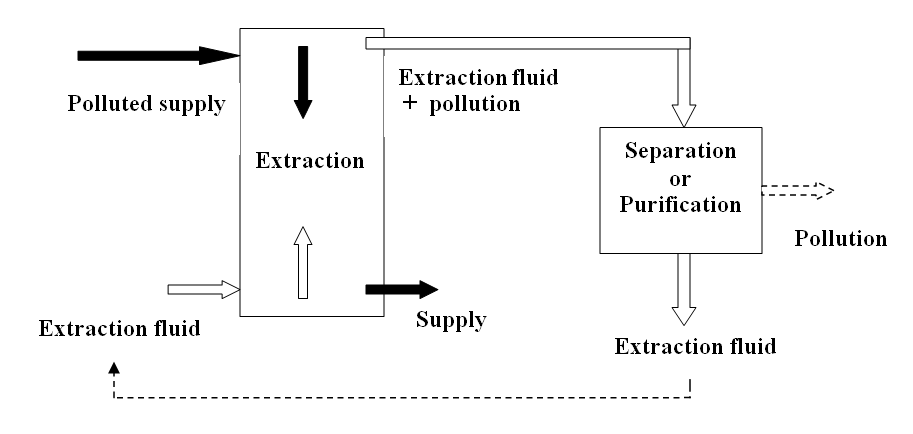Method diagram

Method and installation description
Fluid-fluid extraction is a process that separates substances based on their chemical properties. The theory is to bring the polluted supply flow in contact with a second fluid, namely the extraction fluid. An extraction fluid is selected which does not mix with the supply flow and effectively dissolves the pollutants. During the extraction process, pollutants in the supply slow will (partly) transfer to the extraction fluid until a balance in concentration has been realised. The balance is determined by the affinity that the pollution has with the extraction fluid. If multiple substances are present, the balance will be substance-reliant. In a later step, the pollution is separated from the extraction fluid so it can be re-used.
Extraction can also be used to separate a valuable substance from the supply flow.
Fluid-fluid extraction can be implemented in various ways at industrial scale. Two main categories can be identified:
- The first category consists of mixers-settlers, whereby the extraction process consists of two separate steps. The first step involves mixing the two fluids in order to enable substance transfer. The second step involves separating the two fluids. The two steps can take place in separate reactors.
- The second category involves using columns, whereby the two fluids are in continuous contact with each other. Special measures are normally taken to increase the contact surface area between the supply flow and the extraction flow (e.g. dispersion of one fluid, the use of trays or packaging materials, etc.
Specific advantages and disadvantages
Extraction can be implemented for a wide range of organic compounds. Extraction is normally very specific and makes it attractive to re-use extracted substances. The technique can also be used to treat heat-sensitive substances.
However, extraction is cumbersome and rather inflexible. The process normally needs to be designed for the particular substances that need to be separated and/or removed. Thus careful considerable must be given to the solvent, the design of the extraction installation and post-purification.
Application
Fluid-fluid extraction is a well-known separation technique in the chemical processing industry and in non-ferro metallurgy, but is also used to a lot lesser extent in wastewater purification.
The technique is also used for the removal of high-boiling organic matter from watery flows, such as phenols, for example. The technique is also implemented for the selective recuperation of (heavy) metal ions and metal complexes from high concentrations, and can also be used for the selective removal of metals from rinse water in the surface treatment sector.
Boundary conditions
/
Effectiveness
For further information about the effectiveness of extraction, please refer to the cross-reference table for technique versus parameter/parameter group, removability and removability efficiency.
Support aids
Extraction fluid.
Environmental issues
Extraction fluid and pollutants are released as by-products. Environmental issues could accompany the extraction fluid, such as, for example, odour problems from emissions into the air.
Costs
The cost price for extraction will be greatly determined by the particular case.
Parameters that could have a major impact on the final cost price, include:
- The intrinsic efficiency of the intended process (such as e.g. equilibrium distribution of the pollution in the two fluids);
- The required removal efficiency;
- The installation required to clean up the extraction fluid;
- The type of installation that can be implemented;
- Scale size.
The costs for extraction are high compared to more classic purification techniques. The technique is thus implemented in specific cases where the extracted substances and the extraction fluid can be recuperated.
Comments
None
Complexity
No data available.
Level of automation
The process normally has a high level of automation.
References
- Baeyens J., Hosten L., Vaerenbergh E., Wastewater purification, Environment Foundation - Kluwer Ed., 1995
- EIPPCB, Reference Documents on BAT for the Waste Treatment Industries, 2006
- EIPPCB, Reference Document on BAT in Common Waste Water and Waste Gas Treatment / Management Systems in the Chemical Sector, draft February 2009 (revision upon release)
- Hermans J., Process techniques and engineering, Fluid-fluid extraction, Kluwer Ed., 1994
- Perry R.H. and Green D.W., Mc Graw Hill Perry’s Chemical Engineers’ Handbook, 7th Edition, 1997
- VITO-SCT, revision of technical notes WASS, 2009
- Woodard & Curran, Industrial Waste Treatment Handbook, 3rd Edition, Inc., Elsevier, 2006
Version February 2010

